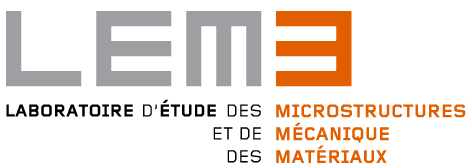- Amphithéâtre 1, ENSAM, 4 rue Augustin Fresnel, 57070 Metz
Jury
- Laurent Duchêne (Université de Liège, rapporteur)
- Issam Doghri (Université catholique de Louvain, rapporteur)
- Shabnam Arbab Chirani (ENSTA Bretagne, examinatrice)
- Léo Morain (Université de Bordeaux, examinateur)
- Farid Abed-Meraim (Arts et Métiers, examinateur)
- Mohamed Ben Bettaieb (Arts et Métiers, examinateur)
Abstract
L’objectif principal de cette thèse de doctorat est d’améliorer les capacités des méthodes et outils numériques développés pour la prédiction des limites de ductilité des tôles métalliques polycristallines à l’aide de la méthode des éléments finis en plasticité cristalline (CPFEM). Cette méthode utilise un Volume Elémentaire Représentatif (VER) polycristallin pour capter avec précision les caractéristiques mécaniques des tôles étudiées. La technique d’homogénéisation périodique est adoptée pour assurer la transition entre l’échelle du VER et celle du monocristal. À l’échelle du monocristal, le comportement mécanique suit une formulation élastoplastique en grandes déformations, avec un écoulement plastique régi par la loi de Schmid. Pour améliorer les capacités prédictives de l’approche numérique développée, les effets de l’écrouissage cinématique, l’écrouissage isotrope basé sur la densité des dislocations, la taille de grains et l’endommagement microscopique sont intégrés dans le modèle constitutif du monocristal. De plus, les effets des paramètres microstructuraux (e.g., textures morphologiques et cristallographiques) sont étudiés. À l’échelle macroscopique, les limites de ductilité sont prédites sous l’hypothèse de contraintes planes en utilisant le critère de bifurcation de Rice. Les résultats de cette thèse démontrent que ces approches multi-échelles avancées fournissent un outil robuste et fiable pour prédire avec précision les limites de ductilité des tôles métalliques polycristallines.
La soutenance sera suivie d’un moment convivial dans la salle B29 du bâtiment B de l’ENSAM.
The main objective of this PhD thesis is to improve the capabilities of the developed numerical methods and tools for the prediction of the ductility limits of polycrystalline metal sheets using the Crystal Plasticity Finite Element Method (CPFEM). This method uses a polycrystalline Representative Volume Element (RVE) to accurately capture the mechanical characteristics of metal sheets. The periodic homogenization multiscale scheme is adopted to ensure the transition between the RVE and single crystal scales. At the single crystal scale, the constitutive framework follows a finite strain rate-independent formulation, with the plastic flow governed by the Schmid law. To improve the predictive capabilities of the developed computational approach, the effects of kinematic hardening, dislocation density-based hardening, grain size, and damage within the framework of Continuum Damage Mechanics (CDM) are incorporated into the single crystal constitutive modeling. Furthermore, the effects of microstructural parameters (e.g., morphological and crystallographic textures) are investigated. At the macroscopic scale, the ductility limits are predicted under the plane-stress assumption using the Rice bifurcation theory. The findings of this thesis demonstrate that these advanced multiscale approaches provide a robust and reliable tool for accurately predicting the ductility limits of polycrystalline metal sheets.
The defense will be followed by a convivial gathering in room B29, building B of ENSAM.





